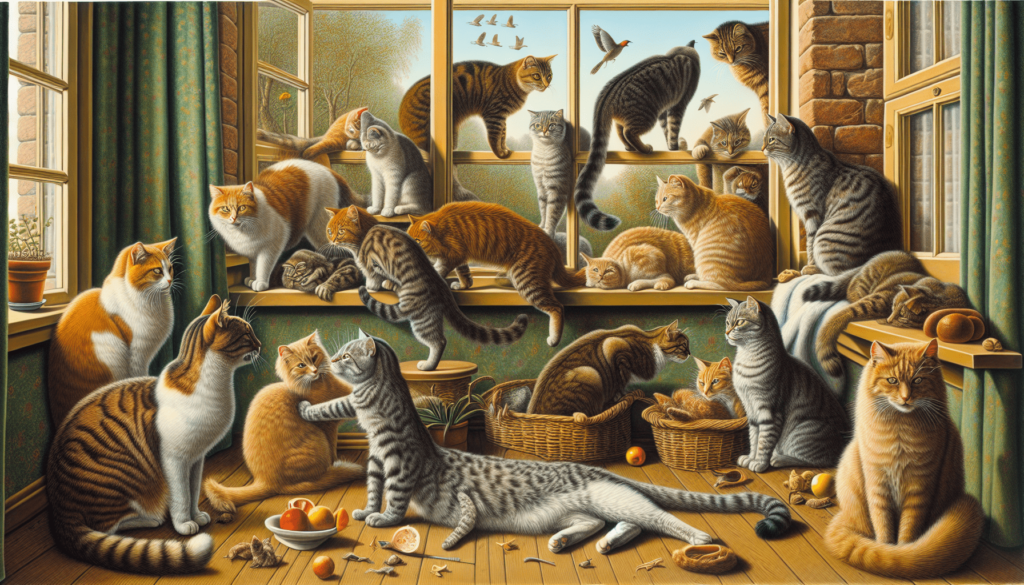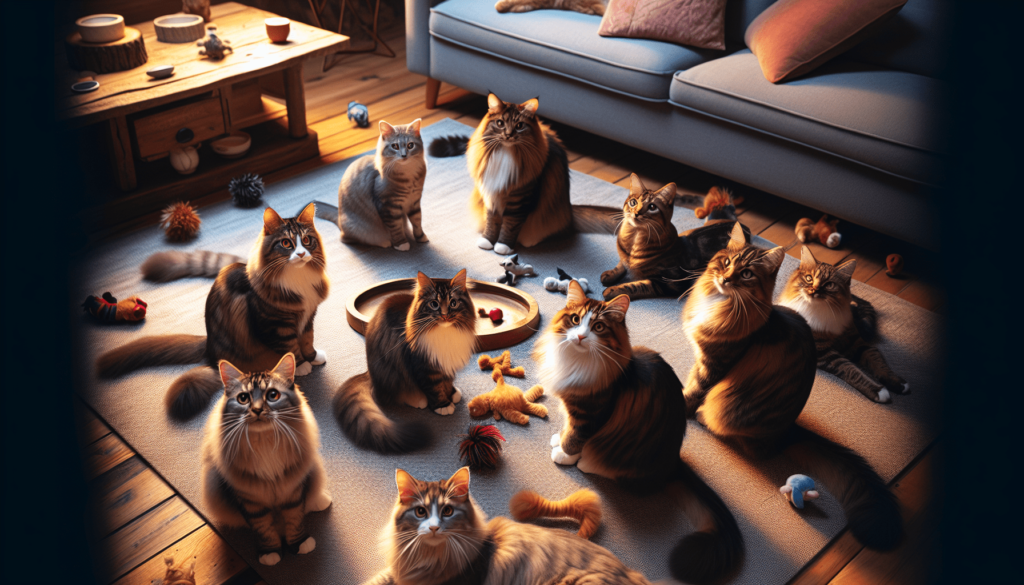Have you ever wondered what a group of cats is called? Well, you’re not alone! Many people are curious about the names given to various animal groups, but cats have a particularly fascinating one. Interestingly, a group of cats is known as a “clowder.” Yes, you read that right – a clowder of cats! This term, with its whimsical ring, perfectly captures the charm and mystery of these graceful animals when they come together. So, the next time you spot a gathering of cats in your neighborhood, you can impress your friends with your newfound knowledge of their unique collective noun – a clowder!
General Definition
Meaning of a group of cats
A group of cats is called a “clowder” or a “glaring.” It refers to a gathering or collection of cats. Cats have a solitary nature, but under certain circumstances, they may form social groups with other cats. These groups can vary in size and dynamics, depending on the environment and the relationship between the cats involved.
Terminology used
In addition to the terms “clowder” and “glaring,” there are a few other names used to describe a group of cats. Some people refer to it as a “clutter” or a “pounce.” These terms are not as commonly used but are occasionally seen in literature or popular culture references.
Etymology
Origin of the term for a group of cats
The term “clowder” originates from the Middle English word “clowdere,” meaning a “ball of string.” It was likely used to describe a group of cats due to their playful nature and tendency to chase after string-like objects. Over time, the term evolved and became widely accepted as the term for a collection of cats.
Evolution of the term
As language and society have evolved, so has the terminology used for a group of cats. While “clowder” remains the most commonly used term, other terms such as “glaring” and “pounce” have emerged, possibly due to their descriptive nature and ability to capture the essence of a group of feline creatures.

Cats in Wildlife
How feral cats group
In the wild, feral cats have a loose and less-defined group structure. They may come together for mating purposes or when resources, such as food or shelter, are limited. Feral cats typically establish a hierarchy within their groups, with dominant individuals having access to the best resources.
Comparisons to other feline groupings
When compared to other wild feline species, such as lions and cheetahs, who live in highly structured social groups, feral cats exhibit more independent behavior. While they may form temporary associations, their social structure remains far less complex.
Cats in Domestic Settings
How domestic cats group
Domestic cats, despite their solitary nature, are capable of forming social bonds. In households with multiple cats, they may develop relationships and form their own unique hierarchy. This hierarchy can influence their interactions, such as play, grooming, and sharing resources.
Contrasts to their feral counterparts
Contrary to feral cats, domestic cats in multi-cat households have the luxury of a stable and consistent environment. The availability of resources and human companionship can shape their interactions and reduce the need for intense competition and aggression. This often results in a more harmonious coexistence among domestic cats.

Cats in Shelters and Colonies
Grouping behaviors of sheltered cats
In shelter environments, cats may be housed together in communal spaces or placed in separate enclosures. The grouping of cats in shelters aims to provide social interaction and mental stimulation. However, it is important to note that not all cats thrive in group settings, as some prefer and require more solitude.
How cat colonies form
In outdoor settings, particularly in urban areas, cat colonies may form naturally. These colonies are often made up of feral or semi-feral cats that share a common food source and shelter. While the cats may not have strong social bonds, they coexist and establish territories within the colony.
Cats in Literature and Media
Usage of the term in popular culture
The term “clowder” or “group of cats” is commonly used in literature and media to evoke imagery or symbolism. It is often used to portray a mysterious or enchanting scene, highlighting the elusive and independent nature of cats.
Famous literary and media examples
In T.S. Eliot’s renowned poetry collection “Old Possum’s Book of Practical Cats,” the term “clowder” is used to describe a group of Jellicle Cats gathering for the Jellicle Ball. Additionally, in the musical adaptation of the same collection, “Cats,” the concept of a clowder is central to the storyline and character dynamics.
Sociology and Group Dynamics of Cats
Understanding cat social structures
Cat social structures are complex and can vary depending on the environment. In both feral and domestic settings, cats may establish hierarchies based on factors like age, size, and assertiveness. These hierarchies play a role in resource access, mating rights, and interaction patterns.
Hierarchy in a group of cats
The hierarchy within a group of cats is usually established through various displays of dominance, including body language, vocalizations, and physical confrontations. The dominant individual typically has priority access to resources and may exert control over other group members. However, it’s important to note that not all groups of cats have a strict hierarchy, and some cats may coexist more as equals than in a hierarchical structure.
Challenges and Benefits of Cat Grouping
Pros and cons of a group of cats
There are both advantages and disadvantages to cat grouping. On one hand, cats in groups may experience increased social interaction, which can improve their overall well-being and decrease feelings of loneliness. They may also learn from each other and engage in play and grooming behaviors. On the other hand, conflicts may arise due to competition for resources or differences in personality. Stress, territorial disputes, and the spread of diseases are potential challenges in a group setting.
Impact on cat behavior
The presence of other cats can significantly impact cat behavior. It can influence their activity levels, play preferences, and overall temperament. Cats in groups may exhibit more pronounced social behaviors, such as grooming each other or engaging in play fights. Additionally, their behavioral repertoire may expand as they learn from observing their feline companions.
Human Interactions with Cat Groups
Human influence on cat groupings
Humans play a significant role in shaping cat groupings, especially in domestic and sheltered environments. Through intentional introductions and management, humans decide which cats will live together and establish boundaries and rules that can influence their interactions. In some cases, humans may also actively manage feral cat colonies by providing resources and implementing trap-neuter-return programs.
Human positive and negative engagements
Human interactions with cat groups can have both positive and negative effects. Positive engagements include providing a stimulating environment, ensuring access to necessary resources, and creating opportunities for socialization. However, negative engagements, such as overcrowding or neglect, can result in stress, inadequate resource allocation, and behavioral problems among the cats.
Frequently Asked Questions
Common misconceptions about cat groups
One common misconception is that all cats should be housed in groups. While some cats thrive in social settings, others prefer a more solitary lifestyle and may become stressed or agitated when forced to live with other cats. It is essential to consider each cat’s personality and needs when determining their living arrangements.
Interesting facts about a group of cats
- Cats in groups often establish a communal litter box area. They may share and use the same designated space for eliminating waste.
- Each cat in a group may have a preferred role or position within the hierarchy. Some cats naturally take on more dominant roles, while others prefer more subordinate roles.
- Cat groups have been known to engage in coordinated hunting behaviors, particularly in feral or outdoor settings where food sources are scarce.
In conclusion, while cats are generally known for their independent nature, they are also capable of forming social groups under various circumstances. Whether it’s in the wild, domestic settings, shelters, or within popular culture, the dynamics of a group of cats can be fascinating to observe. Understanding their behaviors, hierarchies, and the impact of human interactions can contribute to the well-being and harmony within these feline collectives.

